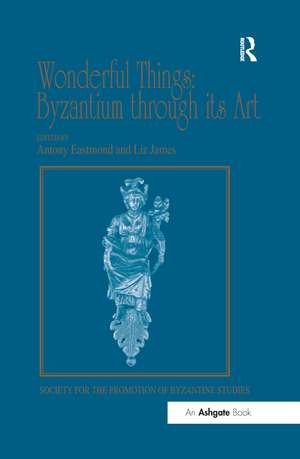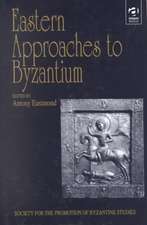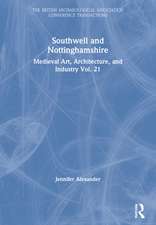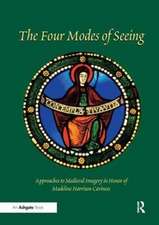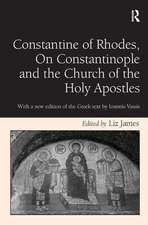Wonderful Things: Byzantium through its Art: Papers from the 42nd Spring Symposium of Byzantine Studies, London, 20-22 March 2009: Publications of the Society for the Promotion of Byzantine Studies
Editat de Liz James, Antony Eastmonden Limba Engleză Paperback – 30 iun 2020
| Toate formatele și edițiile | Preț | Express |
|---|---|---|
| Paperback (1) | 259.98 lei 43-57 zile | |
| Taylor & Francis – 30 iun 2020 | 259.98 lei 43-57 zile | |
| Hardback (1) | 1069.71 lei 43-57 zile | |
| Taylor & Francis – 23 aug 2013 | 1069.71 lei 43-57 zile |
Din seria Publications of the Society for the Promotion of Byzantine Studies
- 9%
 Preț: 971.05 lei
Preț: 971.05 lei -
 Preț: 313.19 lei
Preț: 313.19 lei - 31%
 Preț: 766.65 lei
Preț: 766.65 lei -
 Preț: 489.26 lei
Preț: 489.26 lei - 30%
 Preț: 768.64 lei
Preț: 768.64 lei - 30%
 Preț: 770.31 lei
Preț: 770.31 lei - 31%
 Preț: 766.24 lei
Preț: 766.24 lei -
 Preț: 489.26 lei
Preț: 489.26 lei - 28%
 Preț: 737.19 lei
Preț: 737.19 lei - 9%
 Preț: 1005.06 lei
Preț: 1005.06 lei - 18%
 Preț: 299.52 lei
Preț: 299.52 lei - 18%
 Preț: 1059.45 lei
Preț: 1059.45 lei - 27%
 Preț: 833.77 lei
Preț: 833.77 lei -
 Preț: 401.86 lei
Preț: 401.86 lei -
 Preț: 389.49 lei
Preț: 389.49 lei - 20%
 Preț: 262.75 lei
Preț: 262.75 lei -
 Preț: 386.81 lei
Preț: 386.81 lei -
 Preț: 392.32 lei
Preț: 392.32 lei -
 Preț: 394.01 lei
Preț: 394.01 lei -
 Preț: 394.71 lei
Preț: 394.71 lei
Preț: 259.98 lei
Preț vechi: 334.03 lei
-22% Nou
Puncte Express: 390
Preț estimativ în valută:
49.76€ • 54.07$ • 41.83£
49.76€ • 54.07$ • 41.83£
Carte tipărită la comandă
Livrare economică 21 aprilie-05 mai
Preluare comenzi: 021 569.72.76
Specificații
ISBN-13: 9780367601485
ISBN-10: 0367601486
Pagini: 348
Dimensiuni: 156 x 234 x 23 mm
Greutate: 0.45 kg
Ediția:1
Editura: Taylor & Francis
Colecția Routledge
Seria Publications of the Society for the Promotion of Byzantine Studies
Locul publicării:Oxford, United Kingdom
ISBN-10: 0367601486
Pagini: 348
Dimensiuni: 156 x 234 x 23 mm
Greutate: 0.45 kg
Ediția:1
Editura: Taylor & Francis
Colecția Routledge
Seria Publications of the Society for the Promotion of Byzantine Studies
Locul publicării:Oxford, United Kingdom
Cuprins
Contents: Introduction: Byzantium through its art, Liz James and Anthony Eastmond; Part I Exhibiting Byzantium: Learning lessons: from the Mother of God to Byzantium, Maria Vassilki; ’Of what is past, or passing, or to come’, Robin Cormack; Two scenes from the prehistory of the Byzantine blockbuster, John Hanson; Exhibiting Byzantium: Edinburgh 1958 and London 2008, Rowena Loverance. Part II Object Lessons: Gospel decoration and its relation to artistic and doctrinal trends of the Middle-Byzantine period: a study with reference to the Marciana book covers, Niki J. Tsironis; The stepmum and the servant: the stepson and the sacred vessel, Cecily Hennessy; The Vienna ’empress’ ivory and its companion in Florence: crowned in different glories?, Eileen Rubery; Representing decline and fall: 19th-century responses to the Asclepius-Hygieia and Clementinus ivory diptychs, Helen Rufus Ward; The complexity of the iconography of the bilateral icon with the Virgin Hodegetria and the Man of Sorrows, Kastoria, Teodora Burnand; The last wonderful thing: the icon of the Heavenly Ladder on Mount Sinai. Elena Ene D-Vasilescu; The date of two icons from Sinai, Georgi R. Parpulov; The Nestorian Discos in the light of apocryphal texts and artefacts, Vera Zalesskaya. Part III Byzantium Through its Art: From centre to periphery and beyond: the diffusion of models in late Antique metalware, Anastasia Drandaki; Textiles as text, Anna Muthesius; Some thoughts on Greco-Venetian artistic interactions in the 14th and early-15th centuries, Michele Bacci; Women at tombs: narrative, theatricality, and the contemplative mode, Robert Ousterhout; Show and tell, Leslie Brubaker; The idea of likeness in Byzantium, Anthony Cutler; Mary’s parents in homilies before and after James Kokkinobaphos, Eirini Panou; Constantine’s city: Constantine the Rhodian and the beauty of Constantinople, Marc D. Lauxtermann. Part IV Exhibiting Byzantium Reviewed: Seeing Byzantium: a personal response, Averil Ca
Notă biografică
Antony Eastmond is Reader in the history of Byzantine art at the Courtauld Institute of Art, University of London. He is author of two books, many articles and has edited two volumes of essays. Liz James is professor of art history at the University of Sussex. She is author of two books, many articles and has edited five volumes of essays.
Descriere
The essays collected in this book were delivered at the XLII Spring Symposium of Byzantine Studies, held in London in 2009 to accompany the exhibition Byzantium 330-1453, at the Royal Academy. The exhibition was one of the most ambitious and complex exhibitions ever mounted at the Royal Academy, as well as one of the most popular, and the overall a
